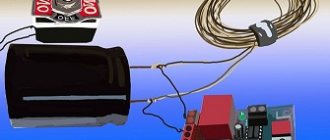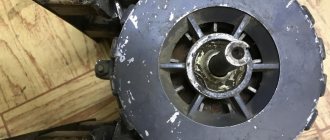American physicist Robert van de Graaff happened to be born and work at the junction of two great scientific eras - electricity and nuclear physics. The generator he created in 1929, which went down in history under his name, was intended for the first physical nuclear research as a particle accelerator. After just two years, the installation produced discharges with a power of up to 7 million volts.
Operating principle of a Van de Graaff generator
The Van de Graaff generator is one of the first linear accelerators. Nevertheless, anyone with even a little knowledge of electrical engineering can reproduce its current model.
The generator consists of two spheres to which positive and negative charges are applied, a dielectric looped tape stretched over 2 rotating rollers (upper and lower), two electrodes in the form of brushes located near the rollers, with the upper electrode closed to the inner surface of the sphere, and the lower connected to a high voltage source.
The device begins to work with the rotation of the tape stretched over the rollers. The top roller is made of dielectric material, and the bottom roller is made of metal with grounding. The upper electrode is connected to a metal sphere, and the lower one, connected to a high voltage source, ionizes the surrounding air and creates positive ions that “stick” to the moving belt.
It, like a conveyor, “delivers” positive charges “up”, where they are removed from the roller by a brush electrode, transferring them to the inner surface of the sphere, where the charges accumulate.
At the same time, negative charges accumulate on the other sphere. As soon as the accumulated potential reaches a critical level, an electrical discharge occurs.
At the dawn of the nuclear age, the Van de Graaff generator was used for a time as a linear particle accelerator. But his active scientific “career” did not last long. Very soon, accelerators of a new generation appeared, incomparable in power and capabilities with their predecessor.
However, unlike its “peers”, electrical devices from the middle of the last century, written off as scrap, the Van de Graaff generator leads a rather active life. From leading research centers it moved to school physical classes and institute laboratories, becoming, for example, an indispensable teaching tool for modeling natural discharges in a gaseous environment.
Perhaps one of the most famous experiences is called the “hair-standing experience.” To do this, you need to stand on a rubber mat or wooden board and touch the switched on Van de Graaff generator. Those with voluminous hair are in for a surprise worthy of a photo and subsequent posting on Instagram.
Experiments with a generator
- When several threads are attached to the upper electrode, and a person brings his hands to them, they will “stand on end.” Try experimenting in complete darkness.
- To obtain a more powerful voltage, two devices are connected to each other.
- A good option is to use a Leyden jar in experiments.
- The most famous experience is one in which the hair stands on end. To do this, you need to stand on a rubber mat, a piece of board or plywood, and place one hand on the sphere (the generator cannot be turned on, otherwise the person will receive an electrical injury). After starting, a spark passes through, which raises the hair.
The device must be discharged after each use, and caution must be exercised during operation, as electric shock can be fatal.
How does a Van de Graaff generator work?
The basis of the Van de Graaff generator is two spheres to which positive and negative charges are applied. Two rotating rollers serve as the basis for a dielectric tape connected into a ring. The upper roller is made of dielectric, the lower one is made of a grounded metal alloy. Near the rollers there are electrodes in the form of brushes, one of which is closed to the inner part of the sphere, and the other is connected to a source of relatively high voltage.
The principle of operation of the Van de Graaff generator is clear even to a schoolchild. Rotation of the tape stretched over the rollers starts the device into operation. The lower electrode, receiving a high voltage current, ionizes the air and creates positive ions that stick to and accumulate on the moving belt. Acting on the principle of a conveyor, the tape delivers positively charged particles to the top of the device, where they are removed by a brush electrode. With its help, the accumulated positive charges are transferred to the inner surface of one of the spheres, where they are further accumulated.
At the same time, negatively charged particles accumulate on the other sphere. As soon as the number of positive and negative charges reaches a critical level, an electrical discharge occurs. Its value directly depends on the duration of operation and the geometric parameters of the device. Thus, Van de Graaff personally managed to obtain about 7 million volts of energy from his invention, building a device of quite impressive size that impressed the inventor’s contemporaries. The models that decorate school laboratories today deliver several hundred volts. This is quite enough to demonstrate the merits of an invention that has learned to collect and accumulate charged particles from the environment.
Request for help
So what should you do if the noise continues, but you can’t reach an agreement? It should be noted that the arrival of a district police officer often simply does not give the results that we would like. Very often, this moment depends on how rampant corruption is in a given area and, of course, on the identity of the offender.
In the event that the local police officer does not take any action on the application or nothing changes after his arrival, you should contact the prosecutor’s office directly, which monitors how the laws are observed. They must sort it out and the answer will come to you in writing.
If they didn’t help here either, then the only thing left is the court. If a claim is filed, there must be strong evidence that it is really impossible for you to relax in your apartment due to noisy neighbors.
Design and principle of operation
The generator design can be vertical or horizontal. The most common is a vertical installation. This generator includes:
- an endless dielectric rubber or silk tape moving at a speed of 20-40 m/s on 2 rotating pulleys;
- 2 pulleys. The lower pulley is made of metal and is rotated by an electric motor, and the upper pulley is made of a dielectric, such as acrylic glass;
- a hollow metal electrode in the form of a hemisphere, inside of which there is an upper pulley. This electrode is mounted on an insulator;
- high voltage source.
The lower pulley is grounded. A high voltage is applied to the electrode located near this pulley. Electrodes made in the form of a brush or comb are installed at a short distance from the upper and lower pulleys. The upper electrode is connected to a hollow hemisphere.
Operating principle of the device
Under the influence of high voltage, positively charged ions are formed in the air layer located between the lower brush electrode and the lower pulley. These ions are attracted to the metal pulley, deposited on the dielectric tape and transported to the hollow hemispherical electrode. Using the top brush electrode, these ions are removed from the tape and fall onto the surface of the spherical electrode. Over time, charge accumulates and the potential of this electrode relative to the ground increases.
The maximum value of the resulting voltage is determined by the discharge voltage that occurs around the spherical electrode as a result of ionization of the air surrounding the electrode. As the diameter of the sphere increases, this stress increases.
To increase it in installations with a relatively small sphere, the device is placed in a hermetic housing, which is filled under a pressure of 20 atmospheres with gases with high electrical strength. These gases include nitrogen, freon and other gases. This housing, made of insulating materials, also serves to ensure the safety of people.
Tandem generator
The tandem generator consists of 2 stages. In such a generator, negative ions are created that fly towards an electrode located at a high positive potential, located in the middle of a gas-filled vessel. Passing through the channel inside the electrode, negative ions with an energy of 10 MeV give up their electrons and turn into positive ions. Next, the beam of these positive electrons moves towards the electrode, which has zero potential. Thus, it is possible to obtain a beam of protons with double the energy.
History of creation
American physicist Robert Van de Graaff (1901-1967), who worked at Princeton University, went down in history as the creator of the electrostatic particle accelerator.
The first description of a Van de Graaff generator was made in 1929, and two years later he created a high-voltage accelerator that could produce an electrical voltage of 1 MV. In 1935, the improved design already produced 7 megavolts.
The Van de Graaff generator later became the basis for a modern type of linear accelerator called a pelletron. The difference between them was the method of transmitting charged particles. If in the generator they were transmitted using a dielectric tape, then in the pelletron they were transmitted by a metal chain.
Purpose and characteristics
The first generator of this type produced a voltage of 80 kV. Subsequently, the inventor obtained voltages of 1 MV and 7 MV. In this case, the voltage of the primary source was 50 kV.
Modern installations make it possible to obtain a voltage of 20 million volts using this generator. Tandem installations are used for this. In this case, the current in the beams can reach several mA, and the particle energy can reach 40-50 MeV.
To produce particles with higher energy, more powerful installations are used - cyclotrons, colliders.
The most powerful Van de Graaff generator was used in the English Daresbury laboratory, where nuclear experiments were carried out from 1983 to 1993. The installation used a tandem generator developing a voltage of 20 MV. This generator was located in a building 70 m high. The most important discovery made with the help of this installation was the discovery of superdeformed nuclei.
Before the war, the Soviet Union also built a large generator of this type. Metal balls with a diameter of 5 m were installed on 2 porcelain insulators. The voltage between the balls reached 15 MV. During the discharge, lightning 15 m in size appeared. At the same time, the charging time reached 10 minutes, and the average power of the installation was less than 100 W.
Generators for experiments and education
Van de Graaff generators can be used to conduct experiments in the fields of physics and electrostatics. At the same time, a large number of generators are available for sale. There are also many different diagrams and designs on the Internet for making a generator yourself.
An example of such a device is a generator produced by the German company 3B Scientific GmbH. The price of such a device is 104,076 rubles.
Main characteristics of the device:
- the generated voltage is about 100 kV;
- short circuit current - 15 µA;
- motor power supply from AC mains;
- power consumption -13 VA;
- dimensions -240x120x620 mm;
- ball dimensions – diameter 90 mm, height 420 mm;
- generator weight -5.8 kg.
When working with this device, you must comply with a number of safety requirements:
- This device may pose a danger to people who are close to the device and have a pacemaker.
- It may cause RF interference to computers and other electronic devices.
- Do not use the device in damp areas.
- Do not touch the device circuits.
- The device can only be plugged into a grounded power outlet.
- When replacing a fuse, be sure to disconnect the device from the mains.
Where is the generator used?
Initially, the device was used to accelerate charged particles, but over time, more advanced accelerators appeared, and the need for it disappeared. Currently, experiments with a Van de Graaff generator are carried out mainly to simulate the processes occurring during lightning discharges.
In modern schools, this device is standard equipment in physical classrooms. The generator was not produced in the territory of the former USSR. In schools, Wimshurst's electrophoric machine was used for experiments, which was later called “Discharge”.
The ability of the generator to produce discharges is used in various show programs and circus tricks. It can create a field that holds small objects in the air, and a powerful charge allows electrical devices to operate far from a source of electricity.
Usage
Van de Graaff generators are often used in atomic research and medicine.
In the first case, they are used to carry out nuclear reactions and to introduce particles into accelerators. Such installations are available in most nuclear laboratories, where researchers deal with particles of low and medium energies. In such accelerators, under the influence of the voltage created by the generator, particle beams are formed and accelerated.
In the second case, generators are used for radiation therapy and research. In this case, beams of particles hit the target and create hard radiation.
In addition, such generators can be used as teaching aids for demonstrating electrostatic phenomena, as well as for studying lightning discharges and lightning strikes.
Precautionary measures
Like any device that produces high voltage, the Van de Graaff generator requires precautions when working with it. The discharge does not matter where it occurs: between oppositely polarized electrodes or between a charged electrode and the human body. A significant difference in potential is enough. Therefore, when working with a generator, a person must be on a rubber mat so that its potential remains neutral with respect to the accumulated charge.
If a person is on the floor, especially on a damp one, then he will become an excellent conductor for transmitting charged particles to the ground, and a discharge of several thousand, and maybe millions of volts will pass through his body. The only thing that can allow a person to stay alive is a low current strength.
People with pacemakers should not approach the generator. Electronic devices such as watches and cell phones may malfunction. Therefore, before starting experiments, you need to leave them aside.
Design features and operating principle of the Hendershot generator
The operation of a fuel-free generator is based on the principle of its connection with the Earth’s magnetic field. The exact geographical location of the latter imposes strict requirements on the location of the device in space relative to the south and north poles. In this case, the device's core could produce an electromotive force directed toward the north or toward the planet's magnetic field.
The rotation movement, according to Hendershot, should occur when crossing the magnetic field from east to west. Two coils with a metal rod, inside which capacitors were placed, were tuned in a special way to constantly be in resonance. Thanks to this, the magnetic field begins to rotate, and an electromotive force is created in the coils. A permanent magnet placed near the coils needs to be charged periodically to keep the generator running.
Practical attempts to use the generator in the experiments of Hendershot Sr. proved the need for careful refinement of the device. The children's airplane to which it was connected managed to take off on its own, overcoming the gravity of the Earth and the gravity of its own weight. However, due to rapid discharge, the toy fell to Earth a few minutes later. The experiment with a 100 W electric light bulb was more successful. When connected to the generator, it glowed, delighting the spectators of Hendershot's experiments. At the same time, realizing the promise of his discovery, Lester carefully hid the specifics of tuning the coils, and this information was not found in his notes.
Source
Generator assembly - what to do before starting work
Generator elements, such as belts, pulleys, and a sphere, attract dust to themselves like a magnet. Before starting work, you need to clean the mechanisms. To do this, you need to remove the large sphere and wipe the parts of the device with a damp cloth. If the accumulated charge does not allow you to get rid of dust, then you can use an antistatic hair spray.
The most important thing to do before starting to rotate the generator is to make sure that the small electrode is grounded. Otherwise, the discharge will hit an object with a larger mass, that is, a person.
Hendershot Generator: Myth or Reality
Little is known about the identity of the inventor himself. Data on scientific developments and twists and turns of fate were made public thanks to Hendershot’s son Mark, who tried to continue his father’s work and bring his scientific research to fruition. It turned out that the first information about the unique engine dates back to the early 30s of the last century. In his scientific notes, Lester claimed that he was able to construct a free energy generator with a power of up to 300 W. For America at that time, trying to cope with the Great Depression, such a statement was like a sensation. Moreover, the inventor himself had only a secondary education and was not widely known in the scientific world for his discoveries and developments.
How to assemble a generator at home - necessary materials
Now that the operating principle of the Van de Graaff generator is known, you can independently assemble a working model for home experiments. After some testing, it turned out that PVC pipe for water supply is best suited for producing charged particles. If you rub it with a synthetic material, the charge that appears in it will allow you to attract small pieces of paper and deflect the stream of water falling down. Therefore, the PVC pipe will become a source of charged particles.
What will transfer electrons to the generator sphere? Experiments have shown that a Martens medical bandage is best suited. It is composed of polyester, latex and cotton fabric.
Now that we have decided on the main working parts, a complete list of necessary materials is compiled:
- Large metal sphere. It is made from two large salad bowls, sold in the nearest hypermarket.
- PVC pipe. You will need 2 pieces of different diameters. The first will become the generator housing, and the second must be selected in such a way that it fits tightly onto the pulley connected to the drive.
- Upper pulley. You can use any suitable object to hold the tape without coming off. For example, an old bicycle wheel hub or a large plastic spool with sides.
- A piece of copper stranded wire. Brushes will be made from it that remove and transmit the charge.
- Low-power electric motor. Required to rotate the lower pulley. However, if desired, the drive can be made manually.
- Metal strips for supporting the generator, as well as for fixing the pulleys on the PVC pipe.
- Metal ladle. It will act as a small electrode.
How will the request to the housing office affect?
There is another authority to which you can file a complaint about particularly noisy upstairs neighbors who just want to annoy them. You should go there if there really are no illegal actions going on, which is rowdy behavior.
For example, a dog is constantly barking somewhere, or there is simply loud music from the upstairs neighbor. In these cases, it is permissible to contact the housing department. As a rule, employees of such an institution say that it is possible to conduct some kind of conversation, but it is not a fact that an apartment will be opened for them. So it's easier to call the police.
However, the police officers are not in a hurry to help, since their exit position is set up only for illegal actions, and loud music is the work of the housing department. And when the circle is closed, you should think about alternative methods.
Do-it-yourself Van de Graaff generator: necessary materials and assembly sequence
To assemble a Van de Graaff generator with your own hands, you will need the following materials:
- Regular pencil;
- Old pasta;
- A piece of PVC pipe;
- Burnt out light bulb;
- A long piece of elastic;
- Aluminum foil and tape;
- 9 volt battery;
- A small wooden plank as a base.
To assemble a Van de Graaff generator, you need to connect all the listed materials and accessories as follows:
- A hole is made in a wooden board for a PVC pipe. To accurately make a hole, use a drill with a suitable sized spade bit.
- Two through holes are made through the tube. They are necessary for placing and tensioning the elastic. The distance between the holes should be such that the rubber band is taut, but does not slow down the operation of the generator with its difficult rotation.
- Two additional holes are made in the tube: the first is slightly higher than the previous one on the same axis, the second is perpendicular to the bottom.
- A piece is cut out of the old hardened paste that fits the diameter of the PVC tube and protrudes from it no more than 1 cm. The first roller is ready.
- The second roller is made in the same way.
- The dielectric film is assembled. It can be made from adhesive tape and an elastic band: cover the elastic band with adhesive tape or simply put it on top to press it against the rollers.
- The design of a minicopy of the Van de Graaff electrostatic generator is ready for assembly. To securely fasten individual parts, it is allowed to use superglue.
- All that remains is to add brushes to collect charged particles and redirect them into the sphere. The lower brush passes through a hole in the bottom of the device, the upper one is fixed above. Both brushes should be close to the rubber band that collects and transports the charge, but not touching it.
- An old non-working light bulb is covered with aluminum foil. The upper wire is connected to the metal surface of the resulting sphere, after which the lamp in foil is fixed in the upper part of the structure.
The device is ready for testing and operation as a static electricity storage device. It is recommended to test and demonstrate it while standing on a rubber mat to avoid electric shock.
Infrasound emitter for noisy neighbors
It has always been believed that my home is my fortress.
However, there are times when it is simply impossible to be in your own apartment. Many things can cause inconvenience: noisy renovation work in a neighboring apartment, very loud music and, naturally, drunken brawls from above every night for a long period of time.
The noise, which continues around the clock, forces us to immediately look for at least some solution to eliminate it. However, not everyone knows how to overcome noisy neighbors.
Do-it-yourself Van de Graaff generator assembly
When all materials are prepared, you can begin manufacturing:
- Make a rectangular base for the generator from metal strips. It must be done in the shape of a square. The dimensions must ensure the stability of the structure. It is also necessary to provide mounting for the electric motor.
- Attach the lower pulley to the motor shaft. Its working surface should be covered with a piece of PVC pipe, which is cut to the width of the Martens bandage.
- Attach the electric motor to the platform so that the pulley is in its center.
- Attach a PVC pipe with a diameter of 150 mm in a vertical position above the pulley. Its length should be 50-60 cm. To make it easy to remove and put on the tape, you need to make an axial cutout 4-5 cm wide on the pipe.
- A second pulley must be installed on the top of the vertical pipe. This is done using fastening brackets.
- Make a sphere from salad bowls. To do this, cut a hole in one of them in the lower part exactly according to the diameter of the pipe. To the same salad bowl around the perimeter you need to solder several staples that will hold the second half.
- Make a brush from stranded wire. To do this, remove the insulation on a length of 2-3 cm and separate the bundle into separate wires. One end of the brush must be secured so that it touches the upper pulley, and the other end must be soldered to the sphere.
- To make an electrode from a ladle, you need to connect the handle to the metal base of the generator and ground it. The handle must be insulated. The same PVC pipe of small diameter is suitable for this.
The prototypes of the Van de Graaff generator in the photo taken a hundred years ago differ little from the device made by hand. Now that the device is completely ready, you can begin the experiments.
Consequences for violators
After the first warning has been issued and there is no effect, an administrative fine is then imposed. Its value will depend only directly on who was the cause for concern - an individual or a legal entity.
The addition to the law states that those who like to place an amplifier on the balcony may also be subject to fines. The law has clear criteria for violating silence, for which you will have to pay a fine:
- Construction and repair work at night;
- Use of pyrotechnics and fireworks;
- Listening to loud music when using amplifiers;
- Whistling, loud screams and more.
Making a Van de Graaff generator with your own hands - step-by-step diagram with photos
Generator assembly process:
Step one. Assembling the generator housing The generator housing consists of PVC pipes; a wooden stand is used as a base. First you need to take the base and glue a piece of plastic pipe 5-7 cm long to it (the diameter of the pipes used is 3/4 inch). Next, a PVC plumbing tee is put on this pipe. Thanks to this design, the device can be easily disassembled if you need to replace the rubber band or carry out any other work inside.
Now you can install the engine; it is inserted into the tee hole and positioned horizontally. If it turns out that the diameter of the motor is too small, it needs to be wrapped with electrical tape; it must fit into the tee body with some effort. In order for the motor shaft to interact with the rubber band, you need to put a piece of tube on it. An ampoule of a helium pen or, best of all, a soft rubber casing from a wire will do; this will provide excellent adhesion to the tape.
After installing the motor, you need to take a drill and drill a small hole opposite the motor shaft. Then you need to insert a piece of stranded wire into it, frayed at the end. It will remove an electrical charge from the tape. The wire can be secured using hot glue or tape. Now all that remains is to put a rubber band on the motor shaft and pull the other end out through the top. After this, you can move on to the next stage.
Step two. Making the second axis Now you need to take another piece of PVC pipe and cut a piece of 5-7 centimeters from it, it will be inserted into the upper part of the tee. The length of this piece of pipe should be such that the elastic is not too tight, otherwise it will not be able to rotate. But the tape should not sag much. Once a certain length has been reached, the elastic can be temporarily secured at the top with a nail.
After installing the cup, three holes need to be drilled in the top of the pipe. Two are needed to insert the second shaft, and the third to establish contact. A nail is used as a shaft, onto which a piece of glass tube is placed. When rotating, it has the smallest friction. The author made such a tube from a glass fuse. To remove metal caps, you must first heat them with a soldering iron and then carefully pull them off with pliers.
Well, then all that remains is to connect the second brush, as in the first case, you need to straighten the bristles on the wire and make sure that it is at a minimum distance from the tape, but does not touch it. The wire is fixed with tape or glue.
Again, to make the system easier to disassemble, you can make the top part removable using a plastic pipe coupling. How to do this can be seen in the photo.
Step three. Final assembly process At this stage the structure will be completely assembled. First you need to fix the cup; for this you can use hot glue or special glue for plastic.
After this, you can install an aluminum can; to do this, you need to cut a hole in its upper part that matches the diameter of the cup. The jar should fit tightly on it.
Thanks to the rounded edges, this can is excellent for working with high voltages, since the “corona discharge” is minimized. You also need to remember to pass the free end of the wire from the top brush inside the can.
What does the law say?
The Federal Law states that the noise level should not exceed 40 dB between seven o'clock in the morning and eleven o'clock in the evening, but at night this figure should not exceed 30 dB.
If we take at least some comparison, then all sounds should be three times quieter than a car alarm. But still, do not forget that in each region amendments to this law can be made.
If the norms are violated by users of residential premises, all actions on the part of unscrupulous neighbors become an administrative violation.
However, it happens that while laws exist, they are unfortunately not implemented. In this case, there are a couple of options to solve the problem.
When very loud music is an obstacle, you can try to negotiate peacefully. This method is undoubtedly considered the best at that moment, if all participants in a given conflict are in an adequate state.
You can explain that you have a small child in your apartment and he needs to rest during the day, but in the evening he should go to bed at nine. You can compromise and understand each other.
In the event that peace negotiations do not go well, you can go to the local police officer, who is supposed to look into this situation at the request of the applicant. If there is a drunken brawl in a neighbor’s apartment, then it is best not to get involved in it, as there is a possibility of getting hurt. In this case, law enforcement agencies must intervene, who will immediately arrive at the scene when called and eliminate the conflict.











